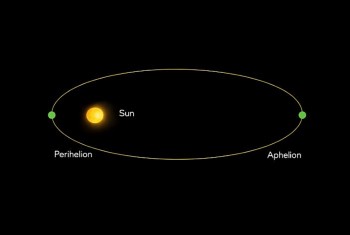8 Facts About Nigersaurus - Dinosaur with 500 Teeth
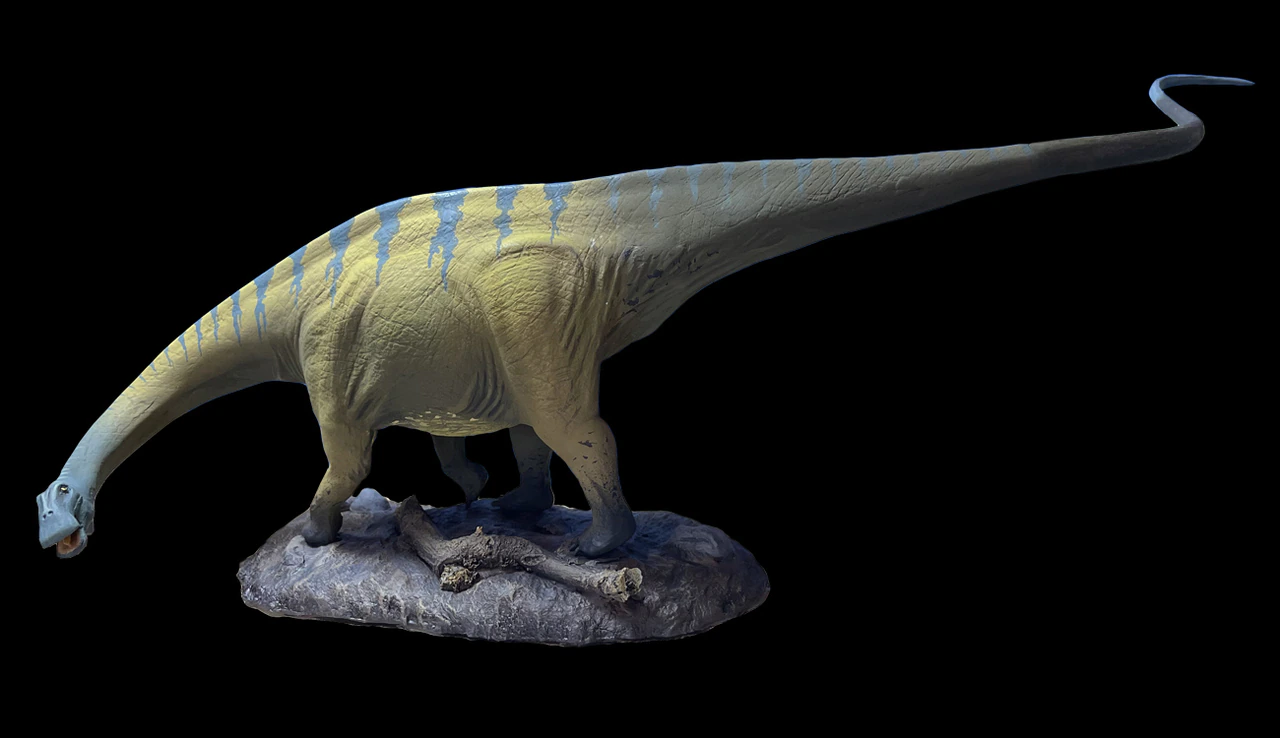 |
| Photo: Dan's Dinosaurs |
Nigersaurus is a genus of rebbachisaurid sauropod dinosaur that lived during the middle Cretaceous period, about 115 to 105 million years ago. It was discovered in the Elrhaz Formation in an area called Gadoufaoua, in the Republic of Niger. Fossils of this dinosaur were first described in 1976, but it was only named Nigersaurus taqueti in 1999, after further and more complete remains were found and described. The genus name means "Niger reptile", and the specific name honours the palaeontologist Philippe Taquet, who discovered the first remains.
Nigersaurus is a 30-foot-long plant-eating dinosaur that lived 110 million years ago in what is now Niger’s Sahara Desert. Nigersaurus lived in a lush environment alongside the predatory dinosaur Suchomimus, the plant eaters ouranosaurus and lurdusaurus, and supercroc. Nigersaurus had a delicate skull and an extremely wide mouth lined with teeth especially adapted for browsing plants close to the ground. This bizarre, long-necked dinosaur is characterized by its unusually broad, straight-edged muzzle tipped with more than 500 replaceable teeth. The original fossil skull of Nigersaurus is one of the first dinosaur skulls to be digitally reconstructed from CT scans.
Bizarre 500-toothed dinosaur
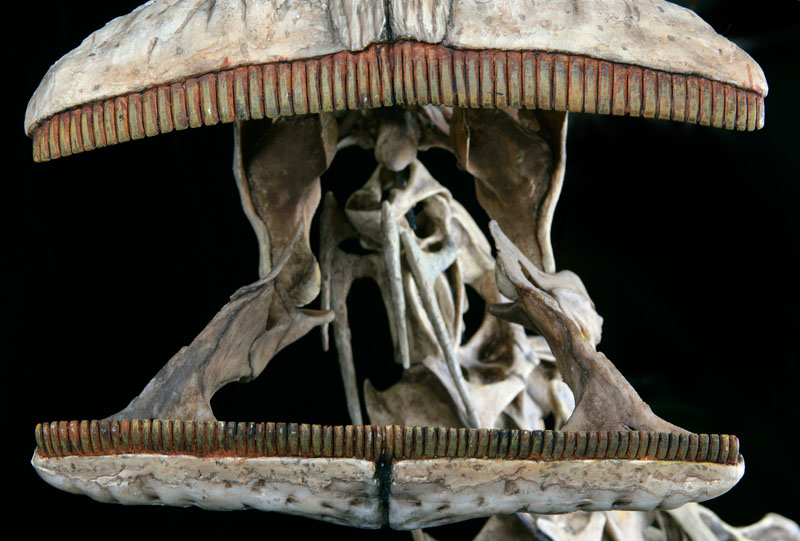 |
| Photo: Discoveries |
Its skull was very specialised for feeding. It had four large side fenestrae, openings in the skull and thin bones. It had a wide muzzle filled with more than 500 teeth, which were replaced around every 14 days. The jaws may have had a keratinous sheath, something like a wide beak. Nigersaurus is the only known tetrapod animal to have had jaws wider than the skull and teeth that extended laterally across the front. The teeth in the upper jaw may have been 20–30% bigger than those in the lower jaw.
Under each active tooth, there was a column of nine replacement teeth within the jaw. With 68 columns in the upper jaws and 60 columns in the lower jaws, these so-called dental batteries comprised a total of more than 500 active and replacement teeth.
The enamel on the teeth of Nigersaurus was highly asymmetrical, ten times thicker on the outwards facing side than on the inner side.
History of discovery
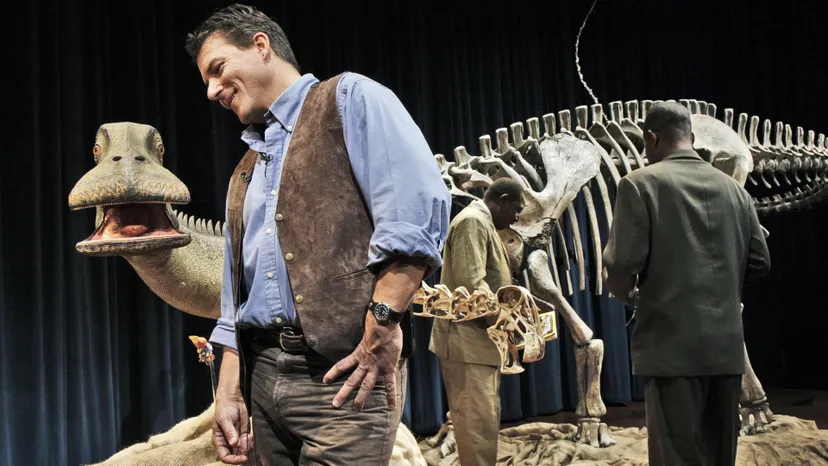 |
| Paul Sereno, Ph.D., left, onstage with Nigerian archeologists Dr. Maga Abdoulaye, left, and Dr. Ide Oumarou, right, with the reconstructed skeleton of Nigersaurus. BILL O'LEARY/THE WASHINGTON POST/GETTY IMAGES |
Remains thought to belong to Nigersaurus were first discovered during a 1965–1972 expedition to the Republic of Niger led by French paleontologist Philippe Taquet, and first mentioned in a paper published in 1976. Although a common genus, the dinosaur had been poorly known until more material of other individuals was discovered during expeditions led by American palaeontologist Paul Sereno in 1997 and 2000. The limited understanding of the genus was the result of poor preservation of its remains, which arises from the delicate and highly pneumatic construction (filled with air spaces connected to air sacs) of the skull and skeleton, in turn causing disarticulation of the fossils. Some of the skull fossils were so thin that a strong light beam was visible through them. Therefore, no intact skulls or articulated skeletons have been found, and these specimens represent the most complete known rebbachisaurid remains.
Nigersaurus was named and described in more detail by Sereno and colleagues only in 1999, based on remains of newly found individuals. The same article also named Jobaria, another sauropod from Niger. The genus name Nigersaurus ("Niger reptile") is a reference to the country where it was discovered, and the specific name taqueti honours Taquet, who was the first to organise large-scale palaeontological expeditions to Niger. The holotype specimen (MNN GAD512) consists of a partial skull and neck. Limb material and a scapula (shoulder blade) found nearby were also referred to the same specimen. These fossils are housed at the National Museum of Niger.
Sereno and the American palaeontologist Jeffrey A. Wilson provided the first detailed description of the skull and feeding adaptations in 2005. In 2007, a more detailed description of the skeleton was published by Sereno ad colleagues, based on a specimen discovered ten years earlier. The fossils, along with a reconstructed skeleton mount and a plastic model of the head and neck, were subsequently presented at the National Geographic Society in Washington.Nigersaurus was dubbed a "Mesozoic cow" in the press, and Sereno stressed that it was the most unusual dinosaur he had ever seen. He likened its physical appearance to Darth Vader and a vacuum cleaner, and compared its tooth shear with a conveyor belt and sharpened piano keys.
Numerous Nigersaurus specimens collected by French and American expeditions remain to be described. Teeth similar to those of Nigersaurus have been found on the Isle of Wight and in Brazil, but it is unknown whether they belonged to relatives of this taxon, or to titanosaurs, whose remains have been found in the vicinity. A lower jaw assigned to the titanosaur Antarctosaurus is likewise similar to that of Nigersaurus, but may have evolved convergently.
******READ MORE: Facts About 'Tiny Alien' Visited Bolivian City after UFO Sighting
8 Fun And Interesting Facts About Nigersaurus
1. Good Grief, Those Jaws Were Weird!
Where to begin? Thanks to its eccentric maw, Nigersaurus is among the strangest-looking dinosaurs known to man. Five hundred teeth were stored in the thing’s muzzle-like jaws, where they were divvied up into 50 vertical columns. That might sound a tad excessive but, according to some estimates, each Nigersaurus tooth had a two-week shelf life before a replacement shoved it out (think of conveyor belts).
Where Nigersaurus truly diverges, however, is in the orientation of these teeth. Like two bony hair combs, the animal’s chompers were arranged in broad, horizontal rows anchored onto jaws which kept all of them at the very front of its snout. Freakishly, this tooth-filled section is wider than the rest of Nigersaurus’ skull!
2. Nigersaurus was Fairly Light-Headed
Its noggin featured some abnormally-thin cranial bones; in fact, many are almost translucent.
3. It Took Scientists Decades to Realize Just How Odd This Critter Was
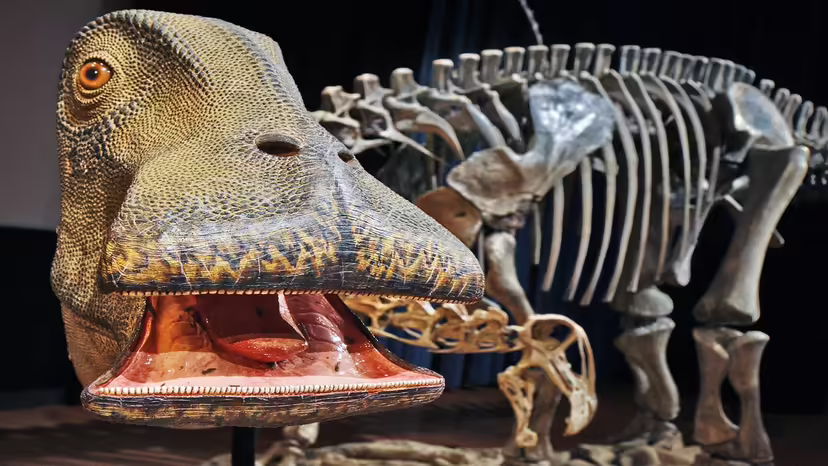 |
| The reconstructed skeleton of a very weird dinosaur, the plant-eater Nigersaurus. This is a sculptural rendition of what the scientists expect the dinosaur's distinct head may have looked like. Behind this, cast reconstructions of the bones have been assembled in the proper shape of the Nigersaurus. BILL O'LEARY/THE WASHINGTON POST/GETTY IMAGES |
Nigersaurus received its scientific name in 1976, but paleontologists wouldn’t get a decent idea of what the animal looked like until the late 2000s. Why? This dino’s skeleton was, in many places, hollow, making it vulnerable to shattering and distortion. Before 1997, though specimens were common, no decent ones had turned up—so for years, few suspected that Nigersaurus was anything other than some run-of-the-mill, Plain Jane sauropod.
4. Nigersaurus Has been Called a “Mesozoic Cow.”
Lawn-mower impersonations seem to have been its forte: Nigersaurus’ wide muzzle and shredding teeth were clearly designed for nomming on ground-level vegetation (for the record, grass-guzzling wouldn’t have been an option, as the earliest grasses hadn’t yet begun evolving in its day).
5. Its Eyes Were Disproportionately Large
Granted, not much about Nigersaurus looks proportionate, but, for reasons unknown, this dino’s cartoonish eye sockets were atypically huge by sauropod standards.
6. Nigersaurus' Spine Was Partially Filled with Air
Its neck vertebrae are little more than delicate skeletal shells. Like many other dinos (and all modern-day birds), many of Nigersaurus’ bones were hollow and likely indicate the presence of a complicated, avian-style respiratory system.
7. Nigersaurus’ Sense of Smell Left a Lot to be Desired
Nigersaurus probably didn’t spend much time following its nose. An examination of its brain cavity reveals that, despite having elongated nostrils, this herbivore’s olfactory lobes (which help the brain perceive scent) were noticeably small.
8. Nigersaurus was a “Short-Necked” Long-Necked Dinosaur
Try repeating that sentence five times fast! Sauropods are usually associated with extensive necks; some well-endowed species even placed over 35 feet between their heads and shoulders. But Nigersaurus and its closest relatives (which together formed a sub-group called the “Rebbachisauridae”) had little to brag about in this department.
 Facts About Blood Moon: Unusual Color, Spiritual Meaning, Myths & Legends Facts About Blood Moon: Unusual Color, Spiritual Meaning, Myths & Legends There are several things about Blood Moon that we don’t know. This article will provide you more knowledge on this phenomenon: Unusual Color, Spiritual Meaning, ... |
 Facts about Elon Musk Sending Dodgecoin-Funded Satellite to the Moon Facts about Elon Musk Sending Dodgecoin-Funded Satellite to the Moon Elon Musk may not have sent dogecoin’s price to the moon with his “Saturday Night Live” appearance, but his SpaceX will accept the cryptocurrency ... |
 Facts About 'Tiny Alien' Visited Bolivian City after UFO Sighting Facts About 'Tiny Alien' Visited Bolivian City after UFO Sighting Local media from Bolivia reported that a tiny alien from deep space paid a visit to the regionfollowing UFO sighting. Facts about that! |
 Only in America: Facts about “Hate-it-all” Chihuahua Prancer Only in America: Facts about “Hate-it-all” Chihuahua Prancer With annoying personality traits and the "hate-it-all" outlook, Prancer the Chihuahua has drawn lots of attractions from netizens worldwide and become the lovely pet that ... |















